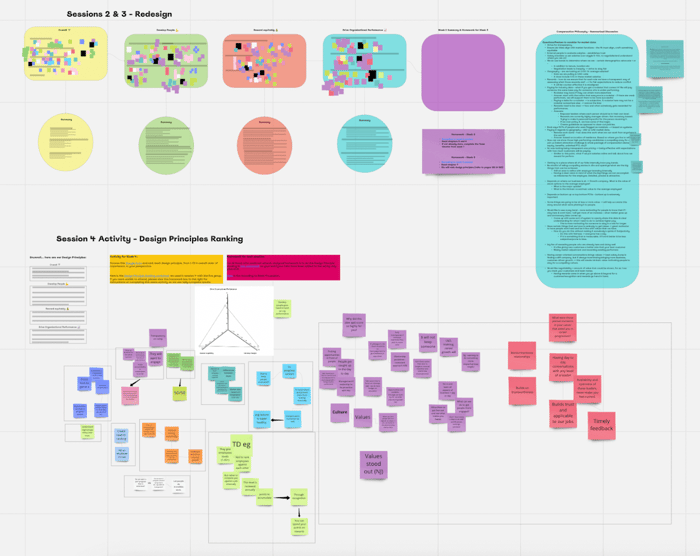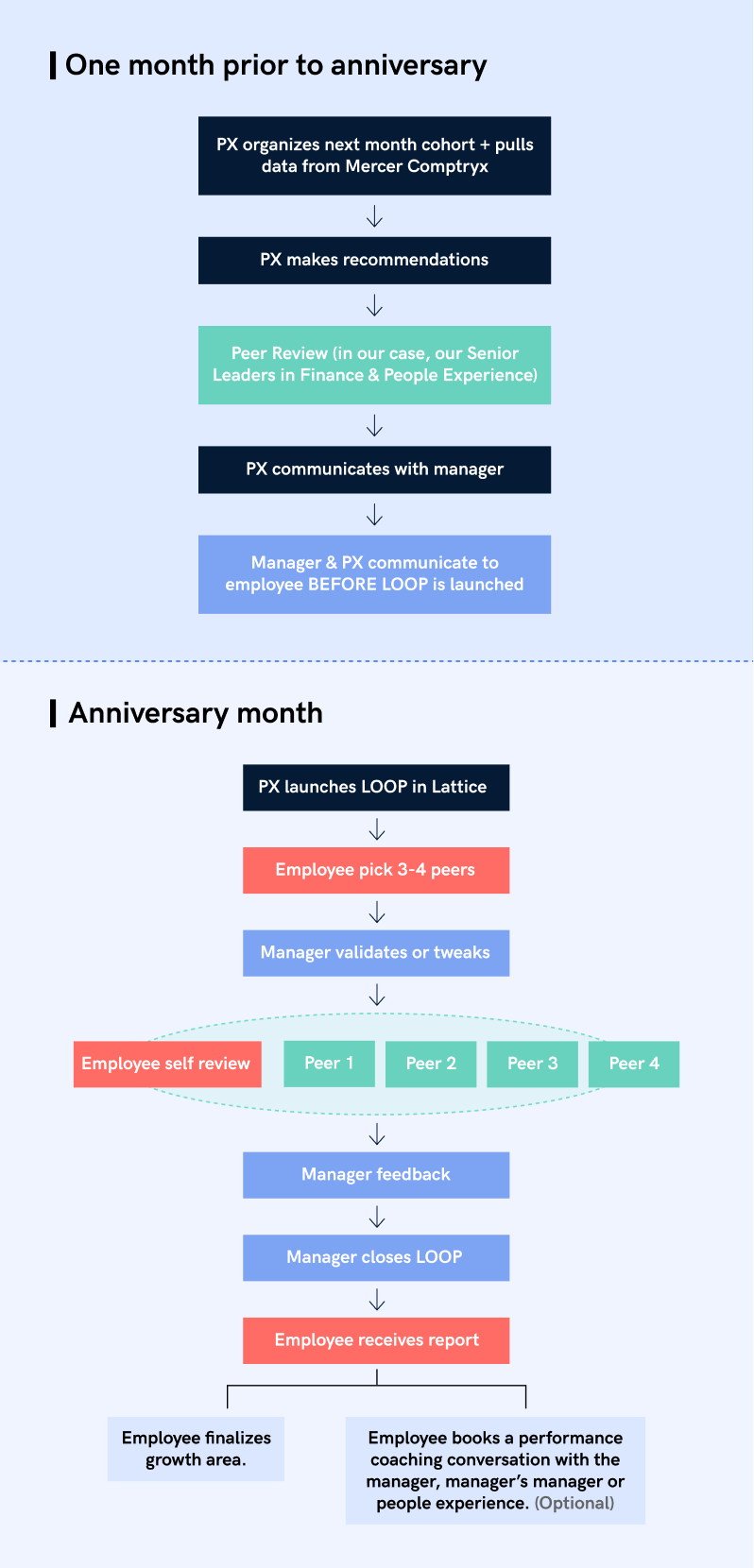Becoming a Performance-Led Culture (One Non-Annual Review at a Time)
First off, it's an honor to get to write about Performance Management. This topic is near and dear to me because it so often misses the mark, or just plain sucks because it can be time-consuming and ineffective.
For those who are wondering what exactly Performance Management is, in simple terms, it’s a process or tool that helps managers gauge an individual’s performance.
This process can help employees understand where they are being effective and where there are opportunities to develop their skills or focus their efforts. Subsequent conversations between managers and employees can also identify career aspirations and paths to get there.
But, before I get into Performance Management at Paystone, let me say that I have tried to crack the performance management code for over 15 years. Yes, 15 years. From the first human resources role I was in, each company tried to design or redesign performance management with few gains along the way.
So while it may sound easy to just make it better, I assure you taking all the failures of my and my team’s past and trying to cook up something fresh, was no small feat.
This brings me to my second point: teamwork.
Performance management in general, is not one person’s job. So neither was the creation of our Performance Management process at Paystone. Everyone in any organization has a vested interest in how performance management works.
Employees need to understand what’s expected of them today, but they also need a way to share how they want to work with the organization going forward (i.e. career development). This helps everyone perform better in their current roles and begins to lay the groundwork for growth, opportunities, and ultimately a meaningful career that hopefully spans many, many years.
To tackle this incredibly important program, we had representation from every department and other diverse voices across our organization. We asked that anyone who wanted to participate had to have been through a performance review process before, and then balanced the team into three groups:
- Individual contributors (across all levels)
- People leaders
- People Experience (aka Human Resources).
Knowing this was going to be a challenging effort, having a great team in place was key to overhauling performance management at Paystone.
Why Paystone Wants a Performance-Led Culture
You may ask, “if you’ve attempted this so many times, why keep trying to do it again?” The answer has two driving factors:
- Our people yearn for something more. They let us know often that something was missing through engagement surveys and conversations. And without knowing exactly what, we deemed it a performance management process.
- We want to achieve extremely ambitious goals at Paystone. To do that, we need people who are both passionate about our purpose and personal growth.
Our People Really Want to Grow
Out of the last four organizations I worked with, three of them had performance management as the top priority for me upon joining. The interesting thing was, in each of those organizations, the call to action wasn’t from the executive team, but from the people.
Not unlike at my previous organizations, the performance management call at Paystone was from the people. However, unlike them, Paystone had a unique quality that could potentially add to the challenge of redesigning a core process, and that is the speed at which we acquire other companies and, with them, new team members.
As you can imagine, every team has their own history and processes that were rooted before becoming part of Paystone. By the time I joined in June 2021, the organization had over six acquisitions under their belt and weathered a pandemic.
Despite these challenges, our people continued to provide feedback that performance management was important to them, but certain pieces were missing.
Reading this, some might think “yeah, I get it,” while others might be scratching their heads, thinking “why in the world would you want to take on a total redesign?”
In short, many people had a need that we weren’t meeting: growth. And we were ready to tackle that through performance management.
Growth is such an interesting concept. It’s incredibly personal and unique to each person, like a fingerprint. When I peeled back a few layers surrounding why people wanted performance management, some very common phrases came up:
- I want to know how to get to the next level (e.g., promotion, different role, and upskilling).
- I don’t know what I don’t know, and I want to know.
- I want to understand how to improve.
- I want recognition for the hard work I’ve done and been doing.
- I want to ensure that work gets documented so that other leaders know how good I am.
- I want to make more money.
Related key phrases also showed up in our employee engagement survey that runs quarterly through Culture Amp:
- People wanted career progression
- Employees wanted someone to show genuine interest in their growth
- Individuals weren’t seeing themselves with the company for more than two years
Which brings us to the most important part of this article…
Paystone’s Goal for Performance Management
Our goal was to design a process that was employee-led, helped individuals grow, and would result in company performance increasing. A by-product would also include improving the employee outlook of their careers extending at the company.
Oh, and let’s not forget, we wanted to make it simple – so simple it would feel like magic, which aligns to Paystone’s core values of thinking people first, solving impactful problems, and building a better future.
But what actually makes ours unique to most performance management processes?
- It started with our employees at the heart of it, not the company.
- It doesn’t tie to cascading goals or OKRs
- It’s not one-size fits all
- Reviews do not inform compensation (gasp, I know!)
- Program success is not based on completion or compliance (double gasp!)
I hope your interest has piqued and you’re curious to see how you can start (re)designing your own plan.
The Process
Before I get into the nitty gritty, I first want to say you absolutely do not require 15 years of experience in human resources to do this. You can be anyone at any point in your career in a position to influence performance management.
The second thing I want to highlight is that I take zero credit for this process, our work was built on “How Performance Management is Killing Performance and What To Do About It” by M. Tamara Chandler.
I have had the fortunate experience of working with the PeopleFirm that helped bring her brilliant work to life and much of this section is a reflection of how the book is organized. I have added several links along the way that are helpful to this process and fill gaps that are beyond this article’s purpose.
Tactics
There are a few tactical items I think are worth noting. This project was completed in an entirely virtual format, spanning four provinces and three time zones.
We used the online whiteboard platform Miro to conduct and capture the majority of our collaborative effort. Using its sticky note feature, helped us anchor to our last sessions and track our process from beginning until end.
We also allocated time from our meeting-free Wednesdays to focus on this interactive process, using three-hour chunks over roughly ten weeks. In its entirety, the 14-person team put almost 300 collective hours into this project.

Rethinking performance
The first phase of our effort was called “Rethink” which breaks down the 8 fatal flaws of Performance Management. This was an incredibly interactive session that saw many in agreement with the fatal flaws, and also quite a few who couldn’t quite conceive a future where those fatal flaws wouldn’t appear in our process.
The fifth fatal flaw, we are not machines, for example, states that “fairness and standardization in ratings and the judgment of performance simply cannot be achieved.”
Some members fought for “better ratings” and “clearer rules” for differentiating performance. Simply put, “give us a really good measuring stick, and we will use it.”
So while you may think the fatal flaws are obvious, they may not be to others. This can create a significant challenge of rethinking or eliminating familiar components/concepts of performance management (even without previous positive experiences), when there is just this learned belief that they ought to be there.
But as we dug in and uncovered some underlying beliefs around the flaws, we began working through the fundamental shifts. And again, the team had these moments of “slow down” and disagreement, but that led to interesting phenomena.
Acknowledging the fatal flaws and shifts to great performance, led us to the three common goals for our performance management process:
- Develop people
- Reward equitably
- Drive organizational performance
But arriving at these common goals also highlighted that each person's needs and desires are different and that a one-size fits most program just would not work for us.
Redesigning our process
These next few sections are really where the team hit the most snags during this process. We didn’t get a true representation across stakeholders to formalize the Paystone triangle and our design principles were quite extensive, which made the drafting stage more difficult.
Where our design principles landed:
- Success means our employees will describe the solution as a transparent process that offers career growth with alignment to company goals.
- The most important outcome is to create a clear and transparent approach that supports an engaged workforce where both personal and professional goals are valued.
- The biggest change our teams will experience is a transparent process that is simple, supportive, and impactful.
Did you pick up on the need for transparency? We definitely did.
Transforming the core work completed by our project team into our first performance management draft took a few weeks. We dedicated time to share ideas and thoughts that honored the hard work of the greater team, our design principles, and the wishes of the executive leadership team. What it resulted in was a pretty incredible process, if we do say so ourselves. Transparent, too!
But wait, what about compensation?
Compensation was probably the most popular topic the team discussed, but as you may remember, we removed its connection to this process. The talk of connecting pay to performance was threaded into every conversation, every week, manifesting in so many ways.
Team members still wanted this performance management process to impact compensation, even with the evidence of bias and inaccuracy when assessing an individual’s performance, as explained in the book
In the end, I had to make the call to completely decouple compensation from performance management. It was a difficult decision because the people we were designing for, the people at the heart of this program, wanted this element.
But between weighing past experience, the evidence, and drive towards equitable compensation against the need to create an evergreen program design, the choice was clear: we would not be designing a pay-for-performance program.
Why in the world would you not pay for performance?
- At Paystone, we want everyone in the company to be the absolute best versions of themselves. Pay-for-performance programs force people to be “better” than others, which directly contradicts our company goal of high talent density (i.e., abundance of collective talent held by employees).
- Pay-for-performance doesn’t work for rockstars. When someone experiences themselves as a rockstar and wants 20% increase, but they only get 5%, that model leads to misalignment between beliefs and reality.
- We want extreme collaboration over competition. For us to hit those ambitious company goals, we all need to be rowing hard, fast, and in the same direction. Imagine hundreds of people rowing at one exact moment, with the same force, in sync, towards the same destination. I would definitely call that extreme collaboration and pay-for-performance undermines that directly and covertly.
I’ve read numerous articles (like this one from Bamboo HR) that all point to the same wants people have in compensation: transparency, trust in the process, and a mechanism to increase it.
We’ve designed a compensation philosophy and process that addresses those elements, perhaps an article for another day, but the key point for Paystone is that the performance management process does not impact compensation.
Rebooting performance management at Paystone
Introducing our newly designed performance management process – drum roll please… LOOP!
We built LOOP, Paystone’s name for Performance Management, in Lattice.

So what’s the result?
Here are a couple of quotes from participants so far:
"The LOOP process is a great way of assessing where I am and where I want to go in the organization, with a strong emphasis on honesty and self reflection" - Ashan Aloysius
"I enjoyed that it was easy to navigate and offered a good range of questions for great feedback" - David Swanson
While early in our new practice, we’ve seen incredible reinforcement that our overarching goal, to ensure our people have meaningful career conversations, is happening.
